Modeling Overview
This introduction will define a travel demand model and lay out the value it provides planners, engineers, and decision-makers. It also provides a broad overview of model types, uses, and requirements.
Part 1: Developing a Travel Demand Model
The overview outlines the model development process. Its iterative nature requires constant feedback to ensure models accurately represent current travel behavior and can reliably forecast future transportation conditions.
The model development process ensures that a travel demand model accurately mirrors the observed travel patterns and needs of the area being simulated. This chapter discusses the early stages of the process including identifying stakeholders, establishing a collaboration plan, scoping the model development process, and drafting the scope document.
This chapter focuses on determining data needs, identifying reliable sources of data, and data collection practices including how to collect it, when to start collecting it, and steps for checking data for errors, reasonableness, and validity.
This chapter focuses on model architecture, calibration and validation, developing the base year scenario, and standardizing reports and outputs.
This chapter details the development of three standard future scenarios after base year model validation. It covers data sources for projections and the three main development components: allocating land use data, developing external traffic models, and coding future transportation networks.
A compilation of resources referenced throughout this portion of the manual.
Part 2: Using a Travel Demand Model
The overview outlines a proven process workflow involving four key roles and emphasizes the iterative nature of using models to answer transportation questions and meet project needs.
This chapter guides users through the initial phase of travel demand modeling projects, focusing on clarifying project requirements, identifying stakeholders, and determining if a model is suitable for the intended purpose.
This chapter explains the concepts of accuracy and precision in travel demand modeling. It covers model validation, reasonableness testing, the dangers of overfitting, and provides detailed procedures for model replication and making models fit for purpose through network refinement and subarea validation.
This chapter focuses on developing and running alternative scenarios to test different transportation and land use conditions, covering baseline scenario preparation, land use data updates, and network modifications.
This chapter details how to extract, analyze, and communicate results from travel demand model scenarios, covering various output types and measures of effectiveness. It emphasizes the importance of tailoring the presentation of results to different audiences and provides extensive guidance on data visualization techniques.


